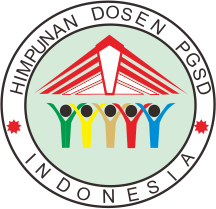Wordwall Labeled Diagram Gamification as a STEM-Based Social Sciences Learning Medium on Students' Critical Thinking Skills
DOI:
https://doi.org/10.30595/dinamika.v17i1.24693Keywords:
Wordwall labelled diagram media, STEM, Critical thinking skills, Learning social sciencesAbstract
One of the skills that must be mastered by students in the 21st century to deal with problems and challenges in their personal and social life is critical thinking. Critical thinking skills can be improved through STEM (Science, Technology, Engineering, And Math) based wordwall labeled diagram gamification learning media. This study aims to determine the effect of wordwall labeled diagram gamification as a STEM-based IPS (Science, Technology, Engineering, And Math) learning medium on students' critical thinking skills. This study uses a quantitative approach to the type of pre-experimental research with a one group pretest–posttest design. The research was conducted on VA class students at State Elementary School 4 Kalibagor, Kalibagor District. The sample used was 21 students, namely 7 boys and 14 girls by purposive sampling. The instruments used are description questions based on indicators of critical thinking skills according to Ennis including elementary clarification, basic support, inference, advance clarification, and strategy and tactics. The critical thinking skills test was carried out in two stages, namely pretest and posttest. Based on the results, the average score for critical thinking skills in the pretest was 58.7% in the sufficient category, while in the posttest it was 81.2% in the very good category. The hypothesis test used was the paired sample t test, the results obtained through the IBM SPSS version 25 software with (0.05%) obtained a significance value (2-tailed) 0.000 <0.05. Based on this study, it can be concluded that H0 is rejected and H1 is accepted, so that there is an influence of wordwall labeled diagram gamification as STEM-based IPS (Science, Technology, Engineering, And Math) learning media on students' critical thinking skills.
References
[1] Azizah, M., Sulianto, J., & Cintang, N. (2018). Analysis of Critical Thinking Skills of Elementary School Students in Learning Mathematics Curriculum 2013. Jurnal Penelitian Pendidikan, 35(1), 61–70. https://doi.org/https://doi.org/10.15294/jpp.v35i1.13529
[2] Anggraeni, N., Rustini, T., & Wahyuningsih, Y. (2022). Keterampilan Berpikir Kritis Siswa Sekolah Dasar Pada Mata Pelajaran IPS Di Kelas Tinggi. Jurnal Kajian Pendidikan Dan Hasil Penelitian, 8(1), 84–90. https://doi.org/https://doi.org/10.26740/jrpd.v8n1.p84-90
[3] Mulyani, T. (2019). Pendekatan Pembelajaran STEM untuk menghadapi Revolusi Industri 4.0. Seminar Nasional Pascasarjana 2019, 7(1), 455.
[4] Maula, N. R., & Fatmawati, L. (2020). Pengembangan Media Pembelajaran Kayaku (Kayanya Alam Negeriku) Berbasis STEM Kelas IV Sekolah Dasar. Jurnal Ilmiah Sekolah Dasar, 4(1), 97. https://doi.org/10.23887/jisd.v4i1.22351
[5] Symonds, Q. (2014). Britain and the Global Index of Cognitive Skills and Educational Attainment. https://www.qs.com/britain-and-the-global-index-of-cognitive-skills-and-educational-attainment/
[6] Sun’iyah, S. L. (2020). Media Pembelajaran Daring Berorientasi Evaluasi Pembelajaran Pada Mata Pelajaran Pai Di Tingkat Pendidikan Dasar. Jurnal Studi Keagamaan, Pendidikan Dan Humaniora, 7(1), 1–18. https://doi.org/https://doi.org/10.52166/dar%20el-ilmi.v7i1.2024
[7] Zuryanty, Hamimah, Ary Kiswanto Kenedi, Y. H. (2020). Pembelajaran STEM Di Sekolah Dasar (Deepublish (ed.)). Deepublish.https://books.google.co.id/books?hl=id&lr=&id=zaAaEAAAQBAJ&oi=fnd&pg=PP1&dq=Zuryanty,+Hamimah,+Kenedi,+A.+K.,+%26+Helsa,+Y.+(2020).+Pembelajaran+Stem+Di+Sekolah+Dasar.+Yogyakarta+:++Deepublish.+Https://Books.Google.Co.Id/Books%3FId%3DZaaaeaaaqbaj&ots=Z8Pj
[8] Pradani, T. G. (2022). Penggunaan media pembelajaran wordwall untuk meningkatkan minat dan motivasi belajar siswa pada pembelajaran IPA di Sekolah Dasar. Educenter, 1(5), 452–457. https://doi.org/https://doi.org/10.55904/educenter.v1i5.162
[9] Permana, S. P., & Kasriman, K. (2022). Pengaruh Media Pembelajaran Wordwall terhadap Motivasi Belajar IPS Kelas IV. Jurnal Basicedu, 6(5), 7831–7839. https://doi.org/10.31004/basicedu.v6i5.3616
[10] Kasa, B., Taneo, S. P., Lehan, A. A. D., Bol, A., Benu, N., Bulu, V., Loko, L. E., & Nota, M. C. G. (2021). Efektivitas Penggunaan Aplikasi Wordwall dalam Pembelajaran IPS Secara Daring ( Online ) di Kelas Tinggi Sekolah Dasar. Haumeni Journal of Education, 1(2), 154–159.
[11] Lestari, Y. I., Amalia, R., & Nugraha, D. (2022). Edukatif : Jurnal Ilmu Pendidikan Pengembangan Video “ Kerinda : Kerajaan Hindu - Buddha ” serta Games Wordwall sebagai Media Belajar IPS di Sekolah Dasar. 4(5), 6606–6616. https://doi.org/https://doi.org/10.31004/edukatif.v4i5.2893
[12] Nur, N., & Jauhar, S. (2022). Analisis Penggunaan Media Pembelajaran Wordwall Berbasis TPACK pada Pembelajaran IPS Siswa Kelas V SDS IT Rabbani Kecamatan Tanete Riattang Kabupaten Bone. Global Journal Teaching Professional, 1(3), 371–378. https://doi.org/DOI.10.35458
[13] Sriyanto, Purwanta, V. (2019). VARIABEL-VARIABEL ESENSIAL PENELITIAN PENDIDIKAN: PEMBELAJARAN. UNS Press.
[14] Jannah, D. R. N., & Atmojo, I. R. W. (2022). Media Digital dalam Memberdayakan Kemampuan Berpikir Kritis Abad 21 pada Pembelajaran IPA di Sekolah Dasar. Jurnal Basicedu, 6(1), 1064–1074. https://doi.org/10.31004/basicedu.v6i1.2124
[15] Dwi, M. (2020). Pemanfaatan Teknologi Pendidikan Di Masa Pandemi Covid-19: Penggunaan Fitur Gamifikasi Daring Di Universitas Muhammadiyah Pringsewu Lampung. Al-Jahiz: Journal of Biology Education Research, 1(1), 14. https://doi.org/https://doi.org/10.32332/al-jahiz.v1i1.2082
[16] Suci, Y. T. (2018). Examining Vygotsky’s Theory and Social Interdependence as The Theory of the Theory in the Implementation of Cooperative Learning in Primary Schools. NATURALISTIC: Journal of Education Research and Learning Studies, 3(1), 231–239. https://doi.org/https://doi.org/10.35568/naturalistic.v3i1.269
[17] Ma’rifah, M. Z., & Mawardi, M. (2022). Peningkatan Kemampuan Berpikir Kritis Siswa Menggunakan Hyflex Learning Berbantuan Wordwall. Scholaria: Jurnal Pendidikan Dan Kebudayaan, 12(3), 225–235. https://doi.org/10.24246/j.js.2022.v12.i3.p225-235
[18] Khan, A., et.al., (2020). Mediating Effect of Positive Psychological Strength and Study Skills on Examination Anxiety among Nigerian College Students, Sustainability 14 (4, 1479)., https://doi.org/10.3390/su12041479
Downloads
Published
How to Cite
Issue
Section
License
Copyright (c) 2025 S. Sriyanto

This work is licensed under a Creative Commons Attribution 4.0 International License.
Authors who publish with this journal agree to the following terms:
Authors retain copyright and grant the journal right of first publication with the work simultaneously licensed under a Creative Commons Attribution License that allows others to share the work with an acknowledgement of the work's authorship and initial publication in this journal.
Authors are able to enter into separate, additional contractual arrangements for the non-exclusive distribution of the journal's published version of the work (e.g., post it to an institutional repository or publish it in a book), with an acknowledgement of its initial publication in this journal.
Authors are permitted and encouraged to post their work online (e.g., in institutional repositories or on their website) prior to and during the submission process, as it can lead to productive exchanges, as well as earlier and greater citation of published work (See The Effect of Open Access).

Dinamika Jurnal Ilmiah Pendidikan Dasar is licensed under a Creative Commons Attribution 4.0 International License.













